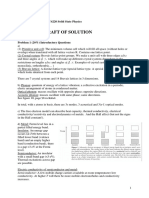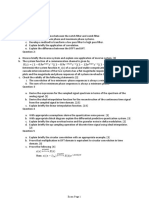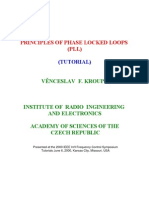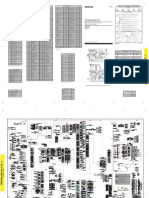0 ratings0% found this document useful (0 votes)
18 viewsNoc21 Ee21 Assignment 1 Week 6 PDF
Noc21 Ee21 Assignment 1 Week 6 PDF
Uploaded by
Μάριος ΗλίαThis document discusses linear time-varying (LTV) electrical networks. It contains 4 problems:
1. The impulse responses of an LTV system represented using the Zadeh expansion are complex values. The impulse response Hk(j2πf) is equal to H-k(j2πf) for a given k. For inputs x(t)=cos(2πft) and sin(2πft), the sum of the outputs of Hk(j2πf) and H-k(j2πf) is zero.
2. The filters Fk(j2πf) in an alternative representation of an LTV system are related to the filters H
Copyright:
© All Rights Reserved
Available Formats
Download as PDF, TXT or read online from Scribd
Noc21 Ee21 Assignment 1 Week 6 PDF
Noc21 Ee21 Assignment 1 Week 6 PDF
Uploaded by
Μάριος Ηλία0 ratings0% found this document useful (0 votes)
18 views1 pageThis document discusses linear time-varying (LTV) electrical networks. It contains 4 problems:
1. The impulse responses of an LTV system represented using the Zadeh expansion are complex values. The impulse response Hk(j2πf) is equal to H-k(j2πf) for a given k. For inputs x(t)=cos(2πft) and sin(2πft), the sum of the outputs of Hk(j2πf) and H-k(j2πf) is zero.
2. The filters Fk(j2πf) in an alternative representation of an LTV system are related to the filters H
Original Title
noc21_ee21_Assignment_1_Week_6.pdf
Copyright
© © All Rights Reserved
Available Formats
PDF, TXT or read online from Scribd
Share this document
Did you find this document useful?
Is this content inappropriate?
This document discusses linear time-varying (LTV) electrical networks. It contains 4 problems:
1. The impulse responses of an LTV system represented using the Zadeh expansion are complex values. The impulse response Hk(j2πf) is equal to H-k(j2πf) for a given k. For inputs x(t)=cos(2πft) and sin(2πft), the sum of the outputs of Hk(j2πf) and H-k(j2πf) is zero.
2. The filters Fk(j2πf) in an alternative representation of an LTV system are related to the filters H
Copyright:
© All Rights Reserved
Available Formats
Download as PDF, TXT or read online from Scribd
Download as pdf or txt
0 ratings0% found this document useful (0 votes)
18 views1 pageNoc21 Ee21 Assignment 1 Week 6 PDF
Noc21 Ee21 Assignment 1 Week 6 PDF
Uploaded by
Μάριος ΗλίαThis document discusses linear time-varying (LTV) electrical networks. It contains 4 problems:
1. The impulse responses of an LTV system represented using the Zadeh expansion are complex values. The impulse response Hk(j2πf) is equal to H-k(j2πf) for a given k. For inputs x(t)=cos(2πft) and sin(2πft), the sum of the outputs of Hk(j2πf) and H-k(j2πf) is zero.
2. The filters Fk(j2πf) in an alternative representation of an LTV system are related to the filters H
Copyright:
© All Rights Reserved
Available Formats
Download as PDF, TXT or read online from Scribd
Download as pdf or txt
You are on page 1of 1
Introduction to Time-Varying Electrical Networks : Week 6
Problem 1
Figure 2: Alternative representation of an LPTV system.
Figure 1: Zadeh expansion of an LPTV system.
The figure above shows the Zadeh expansion of an LPTV net-
work, where k ranges from −∞ to ∞.
Figure 3: LPTV system for problem 3.
a. Are the impulse responses corresponding to Hk (j2πf ) real or
complex? Problem 4
b. What is the relationship between the impulse responses of the
chopper
filters Hk (j2πf ) and H−k (j2πf ) for a given k? R vo a x
c. Suppose that x(t) = cos(2πf t). Determine the output of
vi C1 C2
the branches containing Hk (j2πf ) and H−k (j2πf ). Also b y
determine their sum. Repeat the exercise above for x(t) =
sin(2πf t). What do you conclude? clk
Problem 2 Figure 4: LPTV system for problem 4.
The circuit shown above is an LPTV network. The chopper
Fig. 2 shows an alternative representation of an LPTV system. How
is a network of ideal switches that works as follows. When clk is
are the Fk (j2πf ) related to the Hk (j2πf ) of Fig. 1?
high, nodes a and b are connected to nodes x and y respectively.
When clk is low, nodes a and b are connected to nodes y and x
respectively. The clk signal has a 50% duty cycle and frequency
Problem 3
fs . Denote the zeroth order harmonic transfer function from vi to
vo by H0 (j2πf ). Determine H0 (0).
Fig. 3 shows an LPTV system. Determine its Zadeh expansion.
You might also like
- Physics Class 12 CBSE - All DefinitionsDocument14 pagesPhysics Class 12 CBSE - All DefinitionsDhriti M94% (16)
- Noc21 Ee21 Assignment 1 Week 10 PDFDocument1 pageNoc21 Ee21 Assignment 1 Week 10 PDFΜάριος ΗλίαNo ratings yet
- CPPLL Basics 1680214734Document11 pagesCPPLL Basics 1680214734NimrodMallerNo ratings yet
- Time Domain Representation of Linear Time Invariant (LTI)Document51 pagesTime Domain Representation of Linear Time Invariant (LTI)Wek KivNo ratings yet
- ELC260S Lecture 14 - Kirchhoff's LawDocument15 pagesELC260S Lecture 14 - Kirchhoff's Lawabegail.t.nNo ratings yet
- Tutorial 4Document9 pagesTutorial 4Jabin XingNo ratings yet
- Draft of Solution: EXAM IN COURSE TFY4220 Solid State PhysicsDocument8 pagesDraft of Solution: EXAM IN COURSE TFY4220 Solid State Physicslyon juniorNo ratings yet
- Time Domain Representation of Linear Time Invariant (LTI) SystemsDocument54 pagesTime Domain Representation of Linear Time Invariant (LTI) SystemsJazmi MukhtarNo ratings yet
- Linear Parameter-Varying Modeling and Control Synthesis MethodsDocument20 pagesLinear Parameter-Varying Modeling and Control Synthesis MethodsBliColNo ratings yet
- Modelling and Regulation of Dual-Output LCLC Resonant ConvertersDocument6 pagesModelling and Regulation of Dual-Output LCLC Resonant Convertersbacuoc.nguyen356No ratings yet
- Assignment 1Document11 pagesAssignment 1ilkay KOZAKNo ratings yet
- Homework 5: Note 3BDocument10 pagesHomework 5: Note 3Brusty100% (1)
- Circuits in The Frequency DomainDocument4 pagesCircuits in The Frequency DomainBam BrarNo ratings yet
- Simplest Working Example LaTeX Document-1Document5 pagesSimplest Working Example LaTeX Document-1Soumyadip MondalNo ratings yet
- Detoya Activity3Document17 pagesDetoya Activity3Jay Ian GeronaNo ratings yet
- EP3220 Quiz 2 2024 Solution 2Document6 pagesEP3220 Quiz 2 2024 Solution 2ep21b004No ratings yet
- ODE Lecture 15Document45 pagesODE Lecture 15Zainab BatoolNo ratings yet
- Digital Signal Processing Mock FinaL SolutionDocument5 pagesDigital Signal Processing Mock FinaL Solutiong.odbayar2021No ratings yet
- Tutorial 8Document3 pagesTutorial 8Shriram A ep23b019No ratings yet
- Noc21 Ee21 Assignment 1 Week 8 PDFDocument1 pageNoc21 Ee21 Assignment 1 Week 8 PDFΜάριος ΗλίαNo ratings yet
- Reverse IIRDocument12 pagesReverse IIRPrabhasKumarSinghNo ratings yet
- Examen 2022 Mayo Hints enDocument8 pagesExamen 2022 Mayo Hints enCarlosNo ratings yet
- jψ jωt jφ jωt jωt jψ jφDocument12 pagesjψ jωt jφ jωt jωt jψ jφElectrical EngineersNo ratings yet
- Lec 05Document14 pagesLec 05Adit 0110No ratings yet
- BQP vs. P, BPP, Accuracy 1 Reversible Computation: CS 294-2 9/14/04 Fall 2004Document6 pagesBQP vs. P, BPP, Accuracy 1 Reversible Computation: CS 294-2 9/14/04 Fall 2004Marcos BenícioNo ratings yet
- An Analytic Formula of The Current Distribution For The VLF Horizontal Wire Antenna Above Lossy Half-Space H.-T. Chen, J.-X. Luo, and D.-K. ZhangDocument10 pagesAn Analytic Formula of The Current Distribution For The VLF Horizontal Wire Antenna Above Lossy Half-Space H.-T. Chen, J.-X. Luo, and D.-K. ZhangMilica RancicNo ratings yet
- Assignment 2Document1 pageAssignment 2Disco JockeyNo ratings yet
- Art I Go CN Mac 2024 Armando VelasquezDocument7 pagesArt I Go CN Mac 2024 Armando VelasquezMaria Luisa Velasquez VelasquezNo ratings yet
- 2labman lcr7Document8 pages2labman lcr7RufosNo ratings yet
- S&S Assignment Dec2022Document2 pagesS&S Assignment Dec2022AnonymousNo ratings yet
- ELCE 310 - Lab 2A - Electronic Instrumentation and Measurement LaboratoryDocument6 pagesELCE 310 - Lab 2A - Electronic Instrumentation and Measurement LaboratoryAccountfor YoutubeNo ratings yet
- Question_paper_Phd_Dec19Document4 pagesQuestion_paper_Phd_Dec19banik34244No ratings yet
- Demystifying Class-E Power Amplifiers Design Using MapleDocument4 pagesDemystifying Class-E Power Amplifiers Design Using MapleAriel JimenezNo ratings yet
- Signal and SystemDocument2 pagesSignal and Systemamanmaurya8661No ratings yet
- Complex Low-Pass FiltersDocument15 pagesComplex Low-Pass Filtersanalog.circuit.trainingNo ratings yet
- Kcontrol PDFDocument8 pagesKcontrol PDFVaibhav SharmaNo ratings yet
- Process Motion and Control PDFDocument8 pagesProcess Motion and Control PDFVaibhav SharmaNo ratings yet
- Quantum Mechanics-I (PHYS-0402) Problem Set 5: Ab AbDocument2 pagesQuantum Mechanics-I (PHYS-0402) Problem Set 5: Ab AbArima ChatterjeeNo ratings yet
- Matlab Simulink DC MotorDocument12 pagesMatlab Simulink DC Motorkillua142100% (5)
- ES 442 Homework #2: NAMEDocument8 pagesES 442 Homework #2: NAMEAsadRasheedNo ratings yet
- btech-all-3-sem-network-theory-bees2211-2020Document2 pagesbtech-all-3-sem-network-theory-bees2211-2020idk380254No ratings yet
- Btech All 3 Sem Network Theory Bees2211 2020Document2 pagesBtech All 3 Sem Network Theory Bees2211 2020idk380254No ratings yet
- Planck Quantum HypothesisDocument4 pagesPlanck Quantum HypothesisRamona PirvulescuNo ratings yet
- EC3601 (1) - MergedDocument5 pagesEC3601 (1) - MergedRobin KumarNo ratings yet
- Instructions:: Gujarat Technological UniversityDocument3 pagesInstructions:: Gujarat Technological UniversityJaineshNo ratings yet
- 02 - 08III. A.C. Circuits - 226-231Document1 page02 - 08III. A.C. Circuits - 226-231eamcetmaterialsNo ratings yet
- 09 - ECE 3125 ECE 3242 - Nov 07 2012 - Nyquist Transmission Theory & Duo-Binary SignalingDocument34 pages09 - ECE 3125 ECE 3242 - Nov 07 2012 - Nyquist Transmission Theory & Duo-Binary SignalingEng-Ahmed ShabellNo ratings yet
- Fall_2024_BME311_BSP_HW3Document3 pagesFall_2024_BME311_BSP_HW3Hamza AsjadNo ratings yet
- EEE4221 DSP Lecture 4Document25 pagesEEE4221 DSP Lecture 4David KanikiNo ratings yet
- ELEC442/6601 DSP: Final Exam: Aishy Amer, Concordia University, Electrical & Computer Engineering April 22, 2010Document2 pagesELEC442/6601 DSP: Final Exam: Aishy Amer, Concordia University, Electrical & Computer Engineering April 22, 2010Pindi Prince PindiNo ratings yet
- Lecture6 PDFDocument10 pagesLecture6 PDFMalik SahabNo ratings yet
- Schrodinger Test QuestionsDocument3 pagesSchrodinger Test QuestionsCasonNo ratings yet
- (Ebook - Electronics) - Principles of PLL - Tutorial (Kroupa 2000)Document66 pages(Ebook - Electronics) - Principles of PLL - Tutorial (Kroupa 2000)양종렬No ratings yet
- ECE306end21 3905e4dedb72b1c9ee2aDocument2 pagesECE306end21 3905e4dedb72b1c9ee2aShuvendu DasNo ratings yet
- LC C L X X Also HZ LC: EEET 1003 Electrical Circuit Theory Practical No. 4 Series Resonant Circuit AimDocument3 pagesLC C L X X Also HZ LC: EEET 1003 Electrical Circuit Theory Practical No. 4 Series Resonant Circuit AimEasy OkNo ratings yet
- Feynman Lectures Simplified 2C: Electromagnetism: in Relativity & in Dense MatterFrom EverandFeynman Lectures Simplified 2C: Electromagnetism: in Relativity & in Dense MatterNo ratings yet
- Student Solutions Manual to Accompany Economic Dynamics in Discrete Time, second editionFrom EverandStudent Solutions Manual to Accompany Economic Dynamics in Discrete Time, second editionRating: 4.5 out of 5 stars4.5/5 (2)
- Green's Function Estimates for Lattice Schrödinger Operators and ApplicationsFrom EverandGreen's Function Estimates for Lattice Schrödinger Operators and ApplicationsNo ratings yet
- Noc21 Ee21 Assignment 1 Week 12 PDFDocument1 pageNoc21 Ee21 Assignment 1 Week 12 PDFΜάριος ΗλίαNo ratings yet
- Noc21 Ee21 Assignment 1 Week 11 PDFDocument1 pageNoc21 Ee21 Assignment 1 Week 11 PDFΜάριος ΗλίαNo ratings yet
- New TSV-Based Applications: Resonant Inductive Coupling, Variable Inductor, Power Amplifier, Bandpass Filter, and AntennaDocument5 pagesNew TSV-Based Applications: Resonant Inductive Coupling, Variable Inductor, Power Amplifier, Bandpass Filter, and AntennaΜάριος ΗλίαNo ratings yet
- A Noise Power Ratio Measurement Method For The Accurate Estimation of EVMDocument14 pagesA Noise Power Ratio Measurement Method For The Accurate Estimation of EVMΜάριος ΗλίαNo ratings yet
- An Efficient Algorithm For Simulating Error Vector Magnitude in Nonlinear OFDM AmplifiersDocument4 pagesAn Efficient Algorithm For Simulating Error Vector Magnitude in Nonlinear OFDM AmplifiersΜάριος ΗλίαNo ratings yet
- TV TrainerDocument2 pagesTV TrainerFederico EstradaNo ratings yet
- Uc184xa PDFDocument8 pagesUc184xa PDFFernandoNo ratings yet
- Programmable Controller MCX20B: Technical BrochureDocument6 pagesProgrammable Controller MCX20B: Technical Brochurexie samNo ratings yet
- Nemtek BrochureDocument32 pagesNemtek BrochurestanykeleNo ratings yet
- X5R Dielectric: General SpecificationsDocument6 pagesX5R Dielectric: General SpecificationsDinesh ThevanNo ratings yet
- Assignment 1Document5 pagesAssignment 1Ruvenderan SuburamaniamNo ratings yet
- 4TH SUMMATIVE TEST BE10dcDocument2 pages4TH SUMMATIVE TEST BE10dcmanorenagracelannNo ratings yet
- STM Bda El84 Dual Quad 1 2Document36 pagesSTM Bda El84 Dual Quad 1 2Juan Fco Iso BuenoNo ratings yet
- EN Installation Poster MCC Đ - D19 MHDocument2 pagesEN Installation Poster MCC Đ - D19 MHGiangDoNo ratings yet
- Arduino DroneDocument16 pagesArduino DroneBằng Trần DuyNo ratings yet
- Activity 1Document4 pagesActivity 1Anthony Milano70% (10)
- Motorized Cable Reel Owner's Manual: Type Series HFI and HFIIDocument58 pagesMotorized Cable Reel Owner's Manual: Type Series HFI and HFIIMike PoseidonNo ratings yet
- MID 15-25KTL3-X DatasheetDocument2 pagesMID 15-25KTL3-X DatasheetestebandNo ratings yet
- Current State of Silicone Based Dielectric ElastomerDocument36 pagesCurrent State of Silicone Based Dielectric ElastomerRTC NISERNo ratings yet
- RMO H Brochure - B RMOHN20 313 ENDocument8 pagesRMO H Brochure - B RMOHN20 313 EN2019ht80591No ratings yet
- SE Series Centrifugal Pump Installation & Operating InstructionsDocument2 pagesSE Series Centrifugal Pump Installation & Operating InstructionsKCFUNGNo ratings yet
- Portable Stereo Transmitter: TMR-BT10Document44 pagesPortable Stereo Transmitter: TMR-BT10ВМалиновNo ratings yet
- D5N CFH00442 Sist. Elec.Document4 pagesD5N CFH00442 Sist. Elec.Pablo PorrasNo ratings yet
- L10 ECEN5817 Out1Document9 pagesL10 ECEN5817 Out1carlos.ramNo ratings yet
- 3D Electro-Thermal Study For Reliability of Automotive Power Vertical MOSFET Using COMSOL MultiphysicsDocument4 pages3D Electro-Thermal Study For Reliability of Automotive Power Vertical MOSFET Using COMSOL MultiphysicsAnika TabassumNo ratings yet
- Current and Current Density:: I DQ DT N Q ADocument1 pageCurrent and Current Density:: I DQ DT N Q AccnnqqNo ratings yet
- 5239 PLC SplitterDocument3 pages5239 PLC SplittermksayshiNo ratings yet
- Electrician 1st Year (Volume I of II) TPDocument227 pagesElectrician 1st Year (Volume I of II) TPBanshidhar MahantaNo ratings yet
- Quick Start Guide Emerson 404b Infrared Phototach en 5324858Document24 pagesQuick Start Guide Emerson 404b Infrared Phototach en 5324858ANP ENGINEERINGNo ratings yet
- elba_manualengDocument6 pageselba_manualengDean MinchevNo ratings yet
- Ref List of Edi UpdatedDocument7 pagesRef List of Edi UpdatedEmir AyubNo ratings yet
- Electronics and Communication Engineering: Section 1: NetworksDocument4 pagesElectronics and Communication Engineering: Section 1: NetworksGangadhar Reddy TavvaNo ratings yet
- T8 27PS55S321 7629Document50 pagesT8 27PS55S321 7629Cesar ArteagaNo ratings yet
- 015AZ2.0 015AZ12: Constant Voltage Regulation ApplicationsDocument7 pages015AZ2.0 015AZ12: Constant Voltage Regulation ApplicationsJUANnn100No ratings yet






























































































